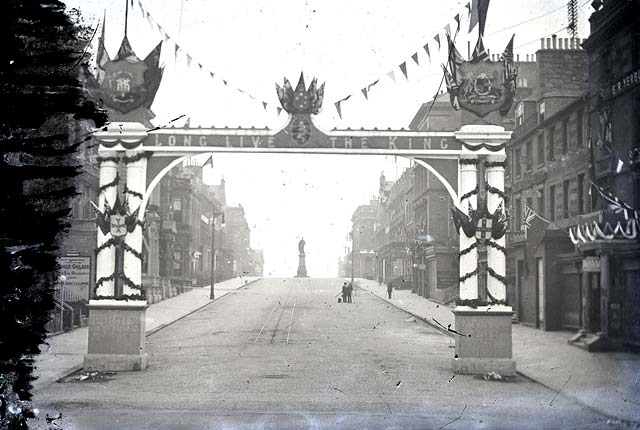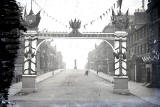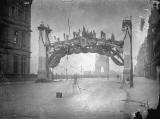|
Hanover Street Looking north from Princes Street towards George Street |
© Reproduced with acknowledgement to Graeme Walker, Kilwinning, Ayrshire, Scotland. Photographer not known.
Coronation ArchHanover Street |
|
Thank you to Graeme Walker for sending me this photograph of Hanover Street, decorated for the Coronation of King Edward VII that was held on August 9, 1902. Graham wrote: |
|
1902 Glass Plates "Here are a couple of images which I think you might find curious. I can't do anything about the state of the glass plates, They had been stored in a shed for decades! They seem to have been taken the morning after the Coronation of Edward VII (by the debris in the gutter!) and show a couple of the archways erected over some of the main roads in Edinburgh. There are a number of other tripods in the shots so I assume it must have been a photographic society outing or similar." Graeme Walker, Kilwinning, Ayrshire, Scotland: June 5, 2011 |
|
Looking to the North ER Yerbury's photographic studio can be seen on the right of this photo. The statue in the distance is to George IV, at the junction of Hanover Street and George Street. |
|
Here is the other photo that Graeme sent to me: Princes Street |
Update1. Graeme Walker Kilwinning, Ayrshire, Scotland |
|
Thank you to Graeme Walker for emailing me again to let me know that the two photos of the Coronation Arches above would have been taken by one of his family. Douglas wrote: |
|
The Photographer "The photographer for these plates was either Gideon Walker or his son Thomas A Walker. They both took photos with Thomas taking over the hobby from his father as he got older: - Gideon would have been aged 59 in 1902. - Thomas would have been aged 22 in 1902." Graeme Walker, Kilwinning, Ayrshire, Scotland: June 5, 2011 |
|
Castle Street Graeme added that he has now done a search on the scran web site, and has found a photograph of a Coronation Arch in Castle Street almost identical to the one in Hanover Street in the photograph above. Graeme Walker, Kilwinning, Ayrshire, Scotland: June 5, 2011 |
Questions1. and 2. Peter Stubbs Edinburgh |
|
Hanover Street Tracks Cable car tram tracks can be seen in the road on this photo: Q1. Why can only one set of tracks be seen in this photo - for cable cars travelling to the north towards Goldenacre? Q2. Why do these tracks not extend over the whole length of Hanover Street? The cable car route between Hanover Street and Goldenacre opened on 28 January 1888. It remained open until 1920. I don't know exactly where in Hanover Street this route terminated. Knowing that might help to answer the questions above. (I believe that the cable car route up the mound did not open until 1900 or later.) Peter Stubbs, Edinburgh: June 6, 2011 |
Replies1. and 2. David KingTrinity, Edinburgh |
|
Thank you to David King for replying quickly to my questions above, and for sending a comprehensive reply. David wrote: |
|
Hanover Street "The photograph is taken from Princes Street, or close to it. (You can see the curve of the kerb at the bottom right hand corner.) Agreed. ER Yerbury's studio, on the right, was on the corner of Princes Street and Hanover Street . - Peter Stubbs "There does just seem to be one line, but if you look closely you can make out pointwork where it splits into double track. At George Street, the two tracks diverged a little and passed one each side of George IV’s statue. The single line formed the terminus – southbound cars ran over the points onto it, then left northbound (towards Goldenacre) on the left hand track. Below the street was a large ‘pit’ built of brick and concrete that contained pulley wheels to make it all happen! This cables were powered from Henderson Row, with Hanover Street as one terminus and Goldenacre (near the Ferry Road junction, i.e. the Edinburgh boundary) as the other. Henderson Row also powered the Comely Bank to Frederick Street route, which terminated similarly just short of the Princes Street junction." The Mound "There was a separate cable line from The Mound via Tollcross to Marchmont Road (powered from Tollcross) which opened, as far as I can find out, on 25 August 1901 - but the connection between that line and the line to the north of Princes Street, involving junctions with the Princes Street line, was not made until the routes were electrified in the 1920s. In the cable days, this would have been a very complex junction to cable and the operating method (the Board of Trade required the cars to be in contact with a cable at all times) would probably have required three or four stops on both the Princes Street and the Hanover Street / Mound routes to pick up and drop cables, which would have slowed the service. The junctions at Princes Street / North Bridge / Leith Street used an arrangement like that, and it took several minutes to go a few hundred yards over the junction." 1920 "By 1920, the Mound route had been cut back from Marchmont Road to Tollcross, possibly to eliminate awkward operation over the Tollcross junction (although they would have to do that to get cars in and out of Tollcross depot). I called this route X on my map on the Granton History Group web site, but it was not numbered in reality." Further Reading "Anyone who wants to find out more may like to read DLG Hunter’s book, ‘Edinburgh’s Transport – The Early Years’ (ISBN 1873644027)." David King: June 6, 2011 |


